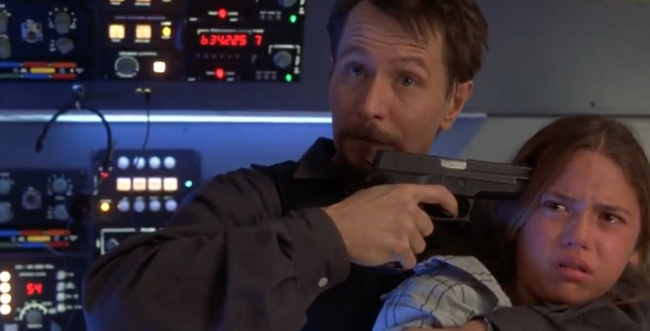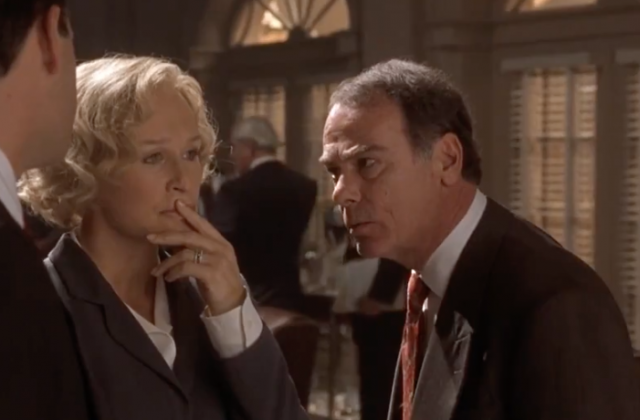Rewind Regrets: Air Force One (1997)
Well-remembered action film has plenty of flaws.

Air Force One is a 1997 action/thriller about a group of hijackers who take over the plane of the President of the United States only to have the President himself fight back.
Sometimes all it takes is a single great performance, or perhaps a single amazing scene to skew your favor for a film. As time passes, that fondness grows and as nostalgia takes hold, cements itself as being the reason why a film is truly memorable. With Wolfgang Peterson‘s action film Air Force One, there are plenty of both, with a hero and villain chewing up the scenery and a few terrific moments that color the film as something special in our minds. A rewatch though, now twenty years later, and things aren’t quite the same.
The story is and always has been a thin one, designed to create action from a simple scenario and then let that thread run its course. This is by no means a fault. Many great films have proven all it takes is a minor situation to become something grand. With Air Fore One, we are introduced to President James Marshall (Harrison Ford), a former decorated soldier and Medal Of Honor recipient giving a speech in Moscow focusing on terror and human atrocities, suddenly announcing a pledge of international participation in a zero negotiation policy with terro groups and further praises the capture of General Ivan Radek (Jürgen Prochnow), the leader of a rogue terrorist regime in Kazakhstan with a plan to restart the Cold War.

Naturally, not everyone is onboard, if you’ll forgive the analogy, with Marshall’s new policy, including Ivan Korshunov (Gary Oldman), a loyalist follower of Radek who has managed to disguise himself and a few others as Soviet journalists, and with the help of a mole named Gibbs (Xander Berkeley) in the president’s security detail, is allowed to join the press corp aboard the plane. Once in the air, they, accessing the weapon’s cache, attempt to take over the flight, and during the attack, it is shown, or at least suggested, Secret Service Agents are able to put the President in an escape pod and jettison him freely away. But you can be sure, especially since his wife (Wendy Crewson) and daughter (Liesel Matthews) are flying with him, Marshall isn’t going anywhere. He’s still onboard. Time for a beatdown.
There’s no taking away the tremendous impact Ford has on one’s impression of Air Force One. The man was a tour de force in the 90s, after an already acclaimed career twenty years before that. He dominates this film of course, his engaging and ultra-likable presence the very reason anyone walking away from it remembers it well. He is the president we all think we want, incorruptible, unbreakable, powerful, and bond to his family. This was half a year before then real-life President Bill Clinton would fall under scandal, but was at this time, hugely popular, a young, energetic leader that seemed capable of what Ford was doing on screen.

Up against Ford was Oldman, a cinematic chameleon who embraces the role of Korshunov with tremendous conviction, and paired with Ford make for a sensational set of leads who clearly push themselves for authenticity. There’s a great moment in the second half where Korshunov gives Marshall an ultimatum, putting the president’s new policy to the test when he draws in his daughter, the very reason the film exists in the first place, the reduction of the theme to its most salient point. The moment is the film’s best, and stands as one of the strongest in both these actor’s careers.
In fact, there’s not a bad performance in the film. Glenn Close shows up as the Vice President, utterly convincing in the part, as are Crewson and Matthews. William H. Macy, fresh off his highly-praised turn in Fargo appears in a small but crucial role as an aid to Marshall, and Dean Stockwell is fiery as the Secretary of Defense down on the ground keeping checks and balances alive with Close. It’s all good stuff.

That said, Air Force One crashes under the weight of own premise, packing itself with a laundry list of action clichés that are now, almost laughable. From a tired–even then–sequence where Marshall must decide which wires to cut (two of five with three being red, white, and blue, it’s not hard to choose) to the myriad fighting and action scenes that fill up the gaps between the often smart dialogue, it’s boilerplate at best. There’s personal sacrifices and a hackneyed air battle defending the plane that is more akin to Top Gun than anything else, and that’s nothing to say about some wholly unconvincing visual effects, especially at the end when a some key moments standing in an open doorway reveal that these actors are more likely standing on a soundstage with fans blowing in their faces rather than at 30,000 feet in the air and falling fast. I’ll skip the abominable CGI effect that follows.
The larger issue is the textbook approach to the screenplay that follows the formula all too closely, even if it has a stellar cast in giving it some life. There are no surprises, and while there are some genuine moments of good tension and conflicts, there is a manufactured feel to it all that leaks into nearly every scene. Nothing feels organic and it all is scaffolded to the eventual end. A rousing score Jerry Goldsmith and some good direction from Peterson help, but Air Force One is a rewind regret, one best left to memories.
